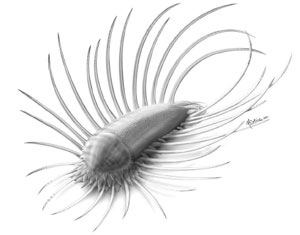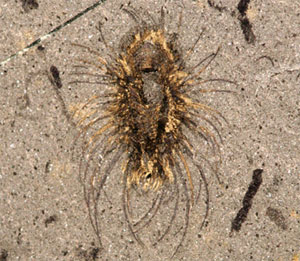Prehistoric spiky freakshow discovered in rock
Prehistoric spiky freakshow discovered in rock
mongabay.com
March 2, 2007
 
(top) Reconstruction of O. reburrus by M. Collins. The precise arrangement of the anterior most |
Scientists have discovered a bizarre, half-billion-year old creature with long, curved spines, armored plates, and a hard shell that protected it from predators.
Writing in Friday’s issue of the journal Science, Simon Conway Morris of Cambridge University and Jean-Bernard Caron of the Royal Ontario Museum in Toronto, say that the new discovery helps researchers better understand early evolution.
They believe the newly described species, known as Orthrozanclus reburrus, may belong to a newly identified group of organisms that are early relatives of modern-day snails, earthworms and mollusks. Morris and Caron say the find “unites two mysterious groups of primitive animals and implies that mollusks may have emerged earlier than previously thought,” according to Science. The species lived about 505 million years ago during the Cambrian Period, a period characterized by the rapid evolution of complex organisms.
Orthrozanclus fossils were found in the Burgess Shale, an ancient rock layer in the Canadian Rockies of southeastern British Columbia. The Burgess Shale has yielded many important fossil finds over the years.